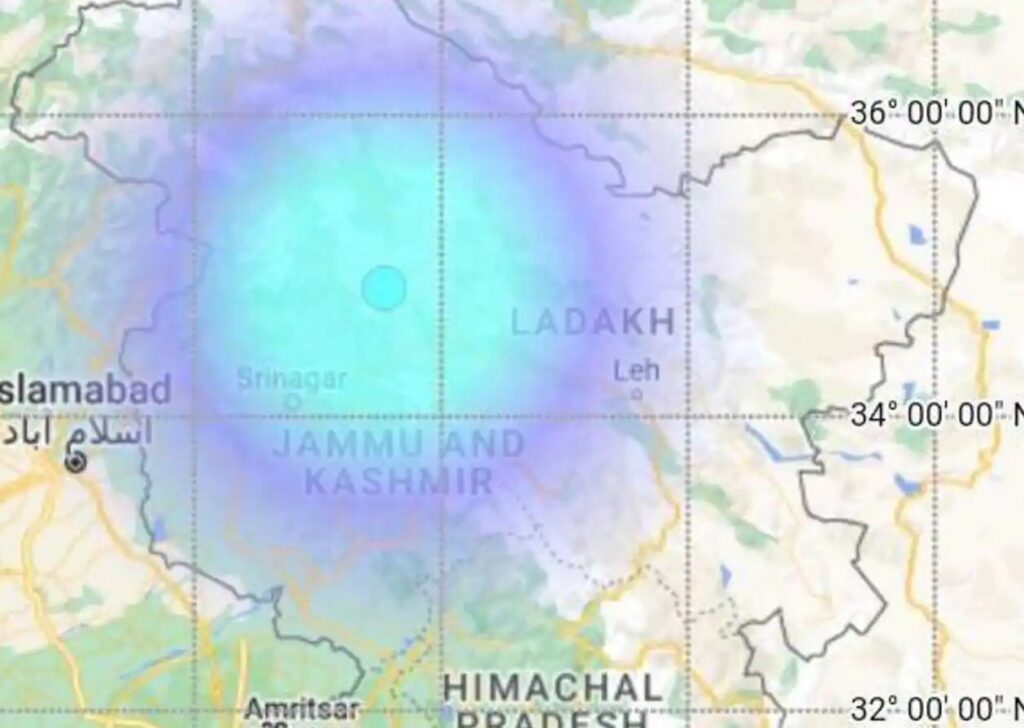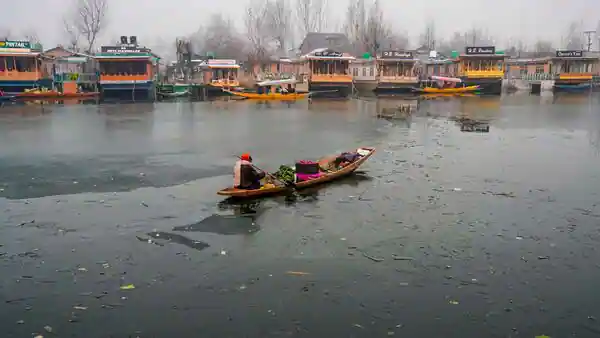5.8 Magnitude Earthquake Jolts the Region: Tremors Felt Strongly in Jammu & Kashmir
Srinagar 19 April 2025: A moderate earthquake measuring 5.8 on the Richter scale struck Afghanistan on Saturday afternoon, sending ripples of tremors across northern India and Pakistan. In Jammu and Kashmir, the tremors were felt sharply, rattling homes and unsettling residents in Srinagar and other parts of the region. The quake has once again highlighted the seismic vulnerability of Kashmir, a region already prone to earthquakes due to its tectonic location.
The Event: Kashmir Shaken
The earthquake, with an epicenter near the Afghanistan-Tajikistan border, struck at a depth of 130 kilometers, according to the National Center for Seismology (NCS).
- Time and Location: The quake occurred at 12:17 PM IST, with coordinates placing it at Lat: 36.10 N, Long: 71.20 E.
- Areas Impacted: Tremors were felt across Jammu and Kashmir, particularly in Srinagar, and extended to parts of Delhi-NCR, Punjab, and Pakistan, including Islamabad, Lahore, and Peshawar.
In Srinagar, locals reported feeling their surroundings shake. “I was in the office when my chair suddenly moved. It lasted only a few seconds, but it was alarming,” said a resident. Across the Valley, tremors disrupted normal activity, with many stepping outside as a precaution.
Kashmir: A Seismic Hotspot
Jammu and Kashmir sits on the Alpine-Himalayan seismic belt, making it one of the most earthquake-prone regions in the world. The Valley has witnessed some of the most devastating earthquakes in history, including the 2005 Muzaffarabad earthquake, which caused widespread destruction and loss of life.
Why Is Kashmir Vulnerable?
The region’s proximity to major fault lines, including the Main Boundary Thrust and the Himalayan Frontal Thrust, makes it highly susceptible to tectonic activity.
- Geological Pressure: The ongoing collision between the Indian Plate and the Eurasian Plate contributes to the frequent seismic activity.
- Past Events: In October 2021, a 6.3 magnitude quake jolted parts of Kashmir, raising concerns about the region’s preparedness.
No Immediate Damage, But Concerns Remain
Despite the strong tremors, there have been no immediate reports of damage or casualties in Jammu and Kashmir. However, authorities have urged residents to stay vigilant, particularly those in vulnerable structures.
- Preparedness Lapses: Many buildings in the Valley, especially in rural areas, fail to adhere to seismic safety standards.
- Emergency Measures: Local authorities have advised people to familiarize themselves with earthquake safety protocols, including identifying safe spaces within homes.
A Wake-Up Call for Disaster Preparedness
While earthquakes cannot be predicted, experts stress the importance of preparedness and structural resilience to minimize damage.
- Public Awareness: Educating residents about earthquake safety can save lives.
- Structural Audits: Ensuring that buildings, especially schools and hospitals, comply with seismic safety norms is critical.
- Emergency Response: Strengthening disaster management systems to handle post-quake scenarios effectively.
Regional Overview: A Day of Shaking Ground
This earthquake in Afghanistan coincided with another minor quake earlier in the day, when a 2.9 magnitude tremor hit Assam’s Nagaon district. While smaller in scale, it served as a reminder of the region’s overall seismic vulnerability.
Kashmir in Focus: Building Resilience
For Kashmir, Saturday’s tremors are a stark reminder of the region’s seismic fragility. The 2005 earthquake taught painful lessons about the devastating impact of inadequate preparedness. Today, while advancements in early warning systems and disaster management have been made, there is still a long way to go.
Key Recommendations for Kashmir
- Upgrading Building Codes: Establishing and enforcing strict construction guidelines to ensure that new buildings can withstand seismic forces.
- Community Drills: Conducting regular earthquake preparedness drills, especially in schools and densely populated areas.
- Strengthening Rural Infrastructure: Many rural homes in Kashmir are built using traditional methods that do not account for seismic safety.




